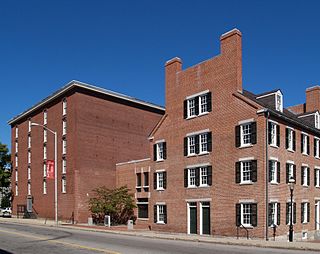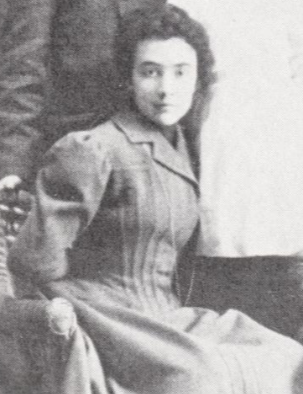Related Research Articles

A quarantine is a restriction on the movement of people, animals and goods which is intended to prevent the spread of disease or pests. It is often used in connection to disease and illness, preventing the movement of those who may have been exposed to a communicable disease, yet do not have a confirmed medical diagnosis. It is distinct from medical isolation, in which those confirmed to be infected with a communicable disease are isolated from the healthy population. Quarantine considerations are often one aspect of border control.

Typhoid fever, also known simply as typhoid, is a disease caused by Salmonella enterica serotype Typhi bacteria, also called Salmonella typhi. Symptoms vary from mild to severe, and usually begin six to 30 days after exposure. Often there is a gradual onset of a high fever over several days. This is commonly accompanied by weakness, abdominal pain, constipation, headaches, and mild vomiting. Some people develop a skin rash with rose colored spots. In severe cases, people may experience confusion. Without treatment, symptoms may last weeks or months. Diarrhea may be severe, but is uncommon. Other people may carry it without being affected, but are still contagious. Typhoid fever is a type of enteric fever, along with paratyphoid fever. Salmonella enterica Typhi is believed to infect and replicate only within humans.

Mary Mallon, commonly known as Typhoid Mary, was an Irish-born American cook believed to have infected between 51 and 122 people with typhoid fever. The infections caused three confirmed deaths, with unconfirmed estimates of as many as 50. She was the first person in the United States identified as an asymptomatic carrier of the pathogenic bacteria Salmonella typhi. She was forcibly quarantined twice by authorities, the second time for the remainder of her life because she persisted in working as a cook and thereby exposed others to the disease. Mallon died after a total of nearly 30 years quarantined. Her popular nickname has since become a term for persons who spread disease or other misfortune, not always aware that they are doing so.

Clarence Seward Darrow was an American lawyer who became famous in the 19th century for high profile representations of trade union causes, and in the 20th century for several criminal matters, including the Leopold and Loeb murder trial, the Scopes "monkey" trial, and the Ossian Sweet defense. He was a leading member of the American Civil Liberties Union and a prominent advocate for Georgist economic reform. Darrow was also well known as a public speaker, debater, and miscellaneous writer. He is considered by some legal analysts and lawyers to be the greatest lawyer of the 20th century. He was posthumously inducted into the Trial Lawyer Hall of Fame.

A boarding house is a house in which lodgers rent one or more rooms on a nightly basis, and sometimes for extended periods of weeks, months, and years. The common parts of the house are maintained, and some services, such as laundry and cleaning, may be supplied. They normally provide "room and board," that is, some meals as well as accommodation.

An asymptomatic carrier is a person or other organism that has become infected with a pathogen, but shows no signs or symptoms.

Sarah Keys v. Carolina Coach Company, 64 MCC 769 (1955) is a landmark civil rights case in the United States in which the Interstate Commerce Commission, in response to a bus segregation complaint filed in 1953 by a Women's Army Corps (WAC) private named Sarah Louise Keys, broke with its historic adherence to the Plessy v. Ferguson separate but equal doctrine and interpreted the non-discrimination language of the Interstate Commerce Act of 1887 as banning the segregation of black passengers in buses traveling across state lines.

Sara Lynn Darrow is the Chief United States district judge of the United States District Court for the Central District of Illinois. She was formerly an Assistant United States Attorney in the United States District Court for the Central District of Illinois, where she was chief of the violent crimes section.

A superspreading event (SSEV) is an event in which an infectious disease is spread much more than usual, while an unusually contagious organism infected with a disease is known as a superspreader. In the context of a human-borne illness, a superspreader is an individual who is more likely to infect others, compared with a typical infected person. Such superspreaders are of particular concern in epidemiology.

Marguerite Kamehaokalani Ashford became the first woman attorney to practice in the Territory of Hawaii. At the time of her 1916 admission to the Hawaii bar, she was the only woman attorney in Hawaii. Almeda Eliza Hitchcock had previously practiced law in the islands while Hawaii was still a kingdom, but had ceased her practice before the 1893 overthrow of the Kingdom of Hawaii. The third woman attorney in Hawaii was Carrick Hume Buck who was admitted to the Hawaii bar in 1924, making Ashford and Buck the only two practicing women attorneys in the territory as of that date.

In 2000, typhoid fever caused an estimated 21.7 million illnesses and 217,000 deaths. It occurs most often in children and young adults between 5 and 19 years old. In 2013, it resulted in about 161,000 deaths – down from 181,000 in 1990. Infants, children, and adolescents in south-central and Southeast Asia experience the greatest burden of illness. Outbreaks of typhoid fever are also frequently reported from sub-Saharan Africa and countries in Southeast Asia. In the United States, about 400 cases occur each year, and 75% of these are acquired while traveling internationally.
The Superior Court of Cook County was a court in Cook County, Illinois.

Guam, one of the external territories of the United States of America confirmed its first case of the COVID-19 pandemic on March 15, 2020, and the first death on March 22. The Government of Guam ordered the general lockdown of the island in mid-March. Governor Lou Leon Guerrero announced the implementation of a four-step "Pandemic Condition of Readiness" (PCOR) on April 30, 2020. Travelers to Guam from designated high-risk areas must provide a recent negative COVID-19 test or undergo mandatory quarantine in a government-approved facility. Guam moved from PCOR 1 to PCOR 2 on May 10, allowing some business activity with restrictions, and then to PCOR 3 on July 20. An outbreak in mid-August was not controlled for several months, resulting in the 7-day rolling test positivity rate to spike above 15% in early October 2020, as well as infections in both the Governor and Lieutenant Governor. Guam announced a return to the lockdown conditions of PCOR 1 on August 14 to control the outbreak, which was not loosened to PCOR 2 until January 15, 2021. It was further relaxed to PCOR 3 on February 21, 2021. From December 2020 to July 2021 cases stayed very low until a surge in August 2021 largely as a result of the delta variant. By October 2021, 90% of the population was vaccinated.

The severe acute respiratory syndrome coronavirus 2 (SARS-CoV-2), the cause of the COVID-19 pandemic, was detected on the aircraft carrier USS Theodore Roosevelt in March 2020 while she was at sea. Affected crew members were evacuated and the ship was ordered to Guam. The captain, Brett Crozier, wanted most of the crew to be removed from the ship to prevent the spread of the disease, but his superiors were reluctant. After several days Crozier e-mailed three of his superior officers and seven other Navy Captains, outlining a plan for the ship to be largely evacuated because the virus could not be contained on board. The letter leaked to the press, and the next day the Navy ordered most of the crew to be taken ashore, but the captain was relieved of command by Acting Secretary of the Navy Thomas Modly. Modly's order was controversial, and his later speech to the crew aboard Theodore Roosevelt was criticized. Modly resigned a few days later. By mid-April hundreds of crew members including Crozier had tested positive for the virus, and one had died.

The COVID-19 pandemic in Niue is part of the ongoing worldwide pandemic of coronavirus disease 2019 caused by severe acute respiratory syndrome coronavirus 2. Niue reported its first confirmed case on 9 March 2022.

John Dill Robertson was a medical professional and politician. He served as Chicago city health commissioner, president of the Chicago Board of Education, and president of the Chicago West Parks Board. In 1927, Robertson ran a third-party campaign for Chicago mayor. As a politician, Thompson was affiliated with the Republican Party. He was an ally of Republican boss Frederick Lundin, and prior to his 1927 mayoral campaign against him, had also long been an ally of William Hale Thompson.
Nancy K. Conn (1919–2013) was a Scottish bacteriologist known primarily for her work on preventing the spread of typhoid in Edinburgh in the summer of 1970.

Herman Niels Bundesen was a German-American medical professional, politician, and author. He served two tenures as the chief health official of the city of Chicago, holding this role for more than 34 years in total. He also was elected Cook County coroner. In 1936, he ran unsuccessfully for the Democratic Party nomination for governor of Illinois.

Madeline Masters Stone was an American sculptor. She was the sister of poet Edgar Lee Masters.
The American Medical Liberty League (AMLL) was an organization headquartered in Chicago which opposed many mainstream medical practices, such as vaccinations and medical licensure. It was extant from 1918 until the early 1930s.
References
- 1 2 3 4 5 6 Walzer Leavitt, Judith (1999). Women and Health in America: Historical Readings. Univ of Wisconsin Press. p. 65. ISBN 978-0-299-15964-1 . Retrieved 31 July 2023.
- 1 2 3 4 5 6 7 8 9 10 Rodkin, Dennis (13 March 2021). "What's That Building? The History Of Chicago's Typhoid Jennie". WBEZ Chicago. Retrieved 31 July 2023.
- 1 2 3 4 5 Hannon, Michael (2010). "Clarence Darrow Illinois Cases" (PDF). University of Minnesota Law Library. Retrieved 31 July 2023.
- 1 2 "Historical Review and Recent Advances - Chapter 24". www.neonatology.org. Mead Johnson Nutritional Division. 1980.
- ↑ "People ex rel. Barmore v. Robertson, 302 Ill. 422 (1922)". cite.case.law. Caselaw Access Project. Retrieved 3 January 2021.